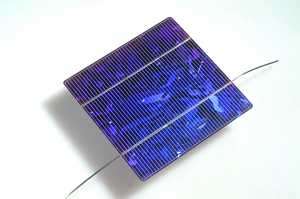Laser joining of solar cells

A single solar cell produces a relatively low output – it’s a case of strength in numbers. Tiny strips of metal are used to link cells together. If the laser soldering temperature is too high, the solder joint may fracture. A new system provides automatic temperature regulation.
Teamwork is what matters – even in the case of solar cells: To obtain sufficient power to operate a pocket calculator, parking ticket dispenser or photovoltaic module, sunlight has to be captured simultaneously by an array of cells. They are connected in series using tiny strips of metal known as stringers.
Each stringer has to be positioned in precisely the right spot, then its solder coating is melted using a hot electrode. When the solder sets, it forms a stable bond with the metallic coating on the silicon. The amount of heat induced in the stringer and the silicon depends on the contact between the soldering electrode and the stringer. Applying too much energy causes thermal stress which in the worst case could destroy the solder joint, leaving a break in the electrical circuit that makes the solar module unfit for use.
Researchers at the Fraunhofer Institute for Laser Technology ILT in Aachen have developed a non-contact soldering system in which the temperature is constantly monitored. If the temperature deviates beyond set limits, the system automatically adjusts it to an acceptable value.
“Instead of an electrode, we use a laser beam for the soldering operation,” says ILT department head Dr. Arnold Gillner. “To melt the solder, we pass a laser beam over the solder-coated stringer. An infrared heat camera derives the temperature of the silicon and of the metal strip from real-time measurements of their emitted radiant heat. If the temperature is too high or too low, a feedback control circuit automatically adapts the laser output within milliseconds.” The system is already in use for industrial surface engineering applications. Solar applications could be on the market in a year or so.
The researchers’ next project is to develop a faster, more reliable method of connecting solar cells by means of laser welding. “Whereas soldering only involves melting the solder, in laser welding the stringer itself is melted,” explains Gillner. This means applying more heat than for soldering, but only for a very short time. “Since the laser is only in contact with the materials for a brief instant, only a small amount of energy is transferred to the materials despite the higher temperature – resulting in even fewer heat-induced defects,” he adds. What complicates the matter is the fact that the stringer has a diameter of about 200 micrometers, whereas the metallic coating on the silicon required to conduct electricity has a thickness of a mere 10 micrometers. The laser beam has to be modulated in such a way that the stringer will melt while leaving the coating on the silicon intact.
Source: Fraunhofer-Gesellschaft





















